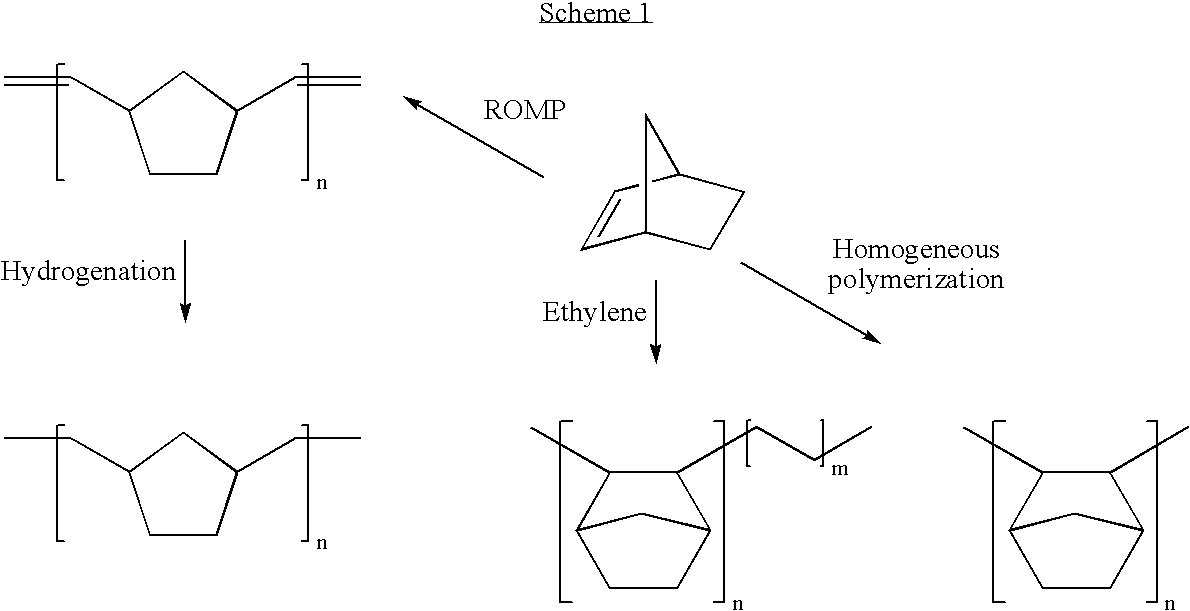Negative c-plate type optical anisotropic film comprising poly cycloolefin and method for preparing the same
a technology of optical anisotropy and polycycloolefin, which is applied in the field of optical anisotropy compensation films, can solve the problems of discotic liquid crystals that cannot be used alone, can not be controlled along the thickness direction by secondary processing, and have relatively large phase differences, so as to achieve no optical loss
- Summary
- Abstract
- Description
- Claims
- Application Information
AI Technical Summary
Benefits of technology
Problems solved by technology
Method used
Image
Examples
preparation example 1
Polymerization of Norbornene Carboxylic Acid Methyl Ester
[0121] A norbornene carboxylic acid methyl ester monomer and purified toluene were added to a polymerization reactor in a 1:1 weight ratio.
[0122] 0.01 mol % (for the monomer content) of Pd(acac)2 dissolved in toluene and 0.01 mol % (for the monomer content) of tricyclohexylphosphine, as catalysts, and 0.02 mol % (for the monomer content) of dimethylanilinium tetrakis(pentafluorophenyl)borate dissolved in CH2Cl2, as a cocatalyst, were added to the reactor. Reaction was carried out for 20 hours while stirring at 80° C.
[0123] After the reaction was completed, the reaction mixture was added to excess ethanol to obtain a white copolymer precipitate. The precipitate was filtered with a glass funnel, and the collected copolymer was dried in a vacuum oven for 24 hours at 65° C. to obtain a norbornene carboxylic acid methyl ester polymer (PMeNB).
preparation example 2
Polymerization of Norbornene Carboxylic Acid Butyl Ester
[0124] A norbornene carboxylic acid butyl ester norbornene monomer and purified toluene were added to a polymerization reactor in a 1:1 weight ratio.
[0125] 0.01 mol % (for the monomer content) of Pd(acac)2 dissolved in toluene and 0.01 mol % (for the monomer content) of tricyclohexylphosphine, as catalysts, and 0.02 mol % (for the monomer content) of dimethylanilinium tetrakis(pentafluorophenyl)borate dissolved in CH2Cl2, as a cocatalyst, were added to the reactor. Reaction was carried out for 20 hours while stirring at 80° C.
[0126] After the reaction was completed, the reaction mixture was added to excess ethanol to obtain a white copolymer precipitate. The precipitate was filtered with a glass funnel, and the collected copolymer was dried in a vacuum oven for 24 hours at 65° C. to obtain a norbornene carboxylic acid butyl ester polymer (PBeNB).
preparation example 3
Copolymerization of Norbornene Carboxylic Acid Butyl Ester-Norbornene Carboxylic Acid Methyl Ester (Norbornene Carboxylic Acid Butyl Ester / Norbornene Carboxylic Acid Methyl Ester=7 / 3)
[0127] A 3:7 molar ratio of norbornene carboxylic acid methyl ester and norbornene carboxylic acid butyl ester were added to a polymerization reactor as monomers. Then, purified toluene was added in a 1:1 (for the total monomer content) weight ratio.
[0128] 0.01 mol % (for the monomer content) of Pd(acac)2 dissolved in toluene and 0.01 mol % (for the monomer content) of tricyclohexylphosphine, as catalysts, and 0.02 mol % (for the monomer content) of dimethylanilinium tetrakis(pentafluorophenyl)borate dissolved in CH2Cl2, as a cocatalyst, were added to the reactor. Reaction was carried out for 20 hours while stirring at 80° C.
[0129] After the reaction was completed, the reaction mixture was added to excess ethanol to obtain a white copolymer precipitate. The precipitate was filtered with a glass funne...
PUM
| Property | Measurement | Unit |
|---|---|---|
| Length | aaaaa | aaaaa |
| Thickness | aaaaa | aaaaa |
| Angle | aaaaa | aaaaa |
Abstract
Description
Claims
Application Information
 Login to View More
Login to View More - R&D
- Intellectual Property
- Life Sciences
- Materials
- Tech Scout
- Unparalleled Data Quality
- Higher Quality Content
- 60% Fewer Hallucinations
Browse by: Latest US Patents, China's latest patents, Technical Efficacy Thesaurus, Application Domain, Technology Topic, Popular Technical Reports.
© 2025 PatSnap. All rights reserved.Legal|Privacy policy|Modern Slavery Act Transparency Statement|Sitemap|About US| Contact US: help@patsnap.com



